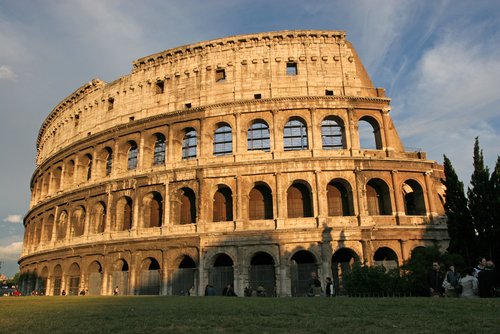


Battle Arena Colosseum...........
The Colosseum hosted spectacular games that included gladiatorial exhibitions, fights between animals, prisoner executions and - strangely enough - naval battles. Untold thousands of humans and animals met their ends within one of the most popular attractions in Rome. The Colosseum's name is derived from a bronze Colossus of Nero that once stood nearby, though it disappeared sometime during the Middle Ages and has largely been forgotten. Construction was begun by Emperor Vespasian and completed by his sons in the late first century.
The arena floor was covered with sand to Soak up the blood shed by those humans and animals Unlucky enough to find themselves in its center. The first level of seating was restricted for Roman Senators and included the emperor's private box. The section above the lower platform was for Roman aristocrats. The third level itself was divided into three sections. The best of these seats was reserved for Wealthy citizens, the upper part for the poor and a third, wooden section was left for lower-class women.
The Roman Colosseum incorporated a number of passageways that opened into a tier of seats so that the entire structure - one of the largest tourist attractions in Rome even then - could fill in 15 minutes, and be evacuated even quicker. During the Baroque age the marble that originally covered the facade was redistributed by the ruling Roman families who used it as a source of marble for the construction of St.. Peter's Basilica and their private Palazzis, a fate that also befell the equally monstrous Circus Maximus located on the other side of the Palatine Hill.
The arena floor was covered with sand to Soak up the blood shed by those humans and animals Unlucky enough to find themselves in its center. The first level of seating was restricted for Roman Senators and included the emperor's private box. The section above the lower platform was for Roman aristocrats. The third level itself was divided into three sections. The best of these seats was reserved for Wealthy citizens, the upper part for the poor and a third, wooden section was left for lower-class women.
The Roman Colosseum incorporated a number of passageways that opened into a tier of seats so that the entire structure - one of the largest tourist attractions in Rome even then - could fill in 15 minutes, and be evacuated even quicker. During the Baroque age the marble that originally covered the facade was redistributed by the ruling Roman families who used it as a source of marble for the construction of St.. Peter's Basilica and their private Palazzis, a fate that also befell the equally monstrous Circus Maximus located on the other side of the Palatine Hill.
No comments:
Post a Comment